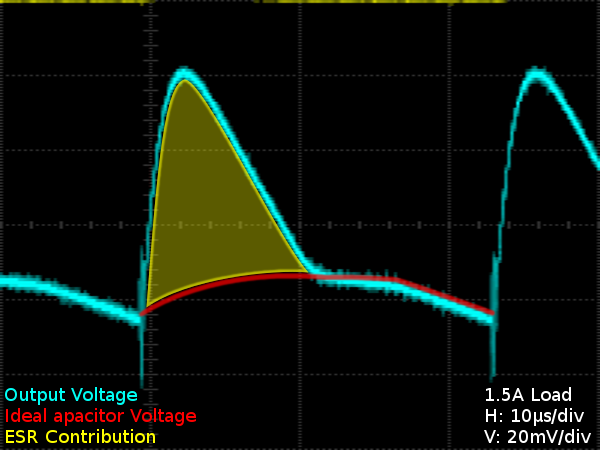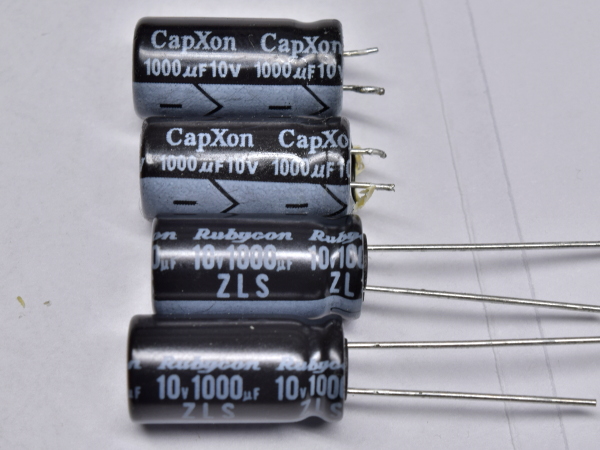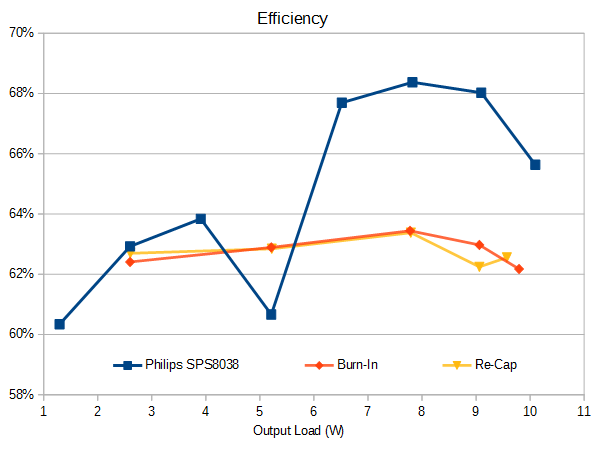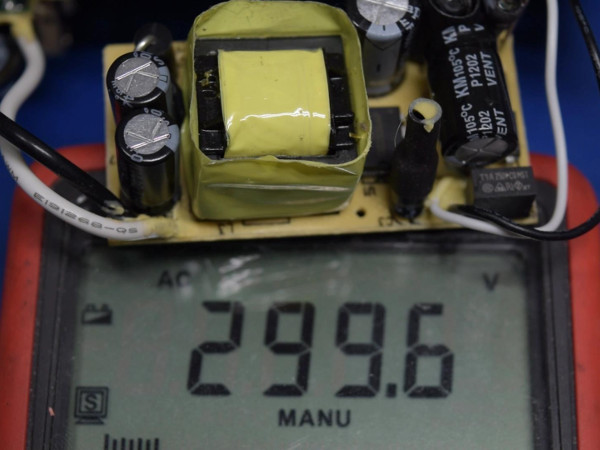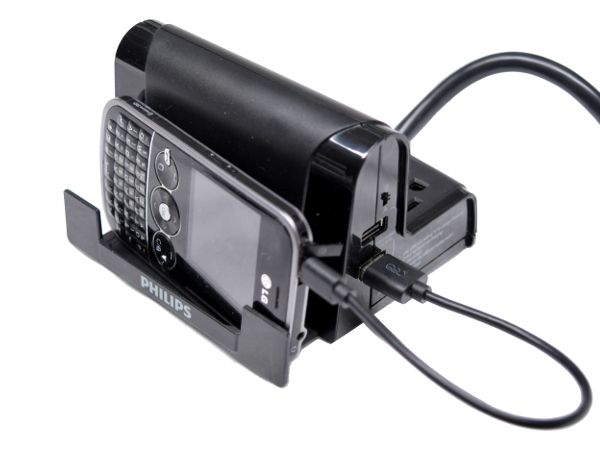Tom's Teardown: Philips SPS8038B AC USB Adapter
RMS Output Noise
The SPS8038B does not break new ground in terms of RMS noise either, mostly because its two large electrolytic capacitors have much higher ESR than Aukey's and SilverStone’s polymer caps.
Why did the peak-to-peak performance get worse below 1.25A when the overall RMS performance improved? Peak-to-peak noise is dominated by switching transients. If the input capacitors' ESR improved from reconditioning, it would cause harsher transients, which explains both noise results and the disappearance of noise bursts timed with AC peaks.
MORE: Tom's Teardown: SilverStone UC01 USB Power Adapter
MORE: How (And Why) We Test USB Power Adapters
Scrutinizing Noise
Noise caused by ESR is the extra voltage that appears while either shoving current into a capacitor or drawing current from it due to impedance. The line in red approximates an ideal capacitor’s voltage, while the yellow zone is extra voltage from the SPS8038B capacitors’ resistance.
What does this tell us about the KF capacitors’ health? There are two of them in parallel rated at 76mΩ feeding a 1.5A load. Since the transformer is directly powering the load ~45% of the time, average current going into the capacitors must exceed 1.5A and the peak be greater still. Sixty millivolts at 1.5A is already 40mΩ. Conclusion? The capacitors’ combined ESR is well under 40mΩ, meaning they’re still well within their passable specs.
MORE: Tom's Teardown: SilverStone UC01 USB Power Adapter
MORE: How (And Why) We Test USB Power Adapters
Transient Response
Transient response looks fairly typical with a 180mV dip upon application and 150mV overshoot upon removal. For comparison’s sake, Aukey scored a 150mV dip and 150mV overshoot.
Get Tom's Hardware's best news and in-depth reviews, straight to your inbox.
While both units settled after the dip within about two milliseconds, Philips' SPS8038S beats the PA-U32 by having its overshoot corrected within three milliseconds versus the better part of 10 for Aukey’s, likely because it has three times the total bulk output capacitance to absorb excess energy before the controller detects the load change.
MORE: Tom's Teardown: SilverStone UC01 USB Power Adapter
MORE: How (And Why) We Test USB Power Adapters
Short-Circuit Response
Upon applying a short circuit, current peaks at about 7.5A as the capacitors dump their charge into the short, promptly drops to less than 1.25A, slowly drifts down to 800mA, and cuts off after 50ms. Once over-current protection is tripped, the controller waits approximately one second before restarting.
MORE: Tom's Teardown: SilverStone UC01 USB Power Adapter
MORE: How (And Why) We Test USB Power Adapters
The Replacement Test
What do you do when you have a growing inventory of spare parts and wonder if a capacitor swap would do any good?
Bye bye 76mΩ CapXon KF with 1ARMS ripple rating; hello 45mΩ Rubycon ZLS with 1.2ARMS ripple rating.
MORE: Tom's Teardown: SilverStone UC01 USB Power Adapter
MORE: How (And Why) We Test USB Power Adapters
Moment Of Truth
Well, 45mΩ is 60% of 76mΩ, and 40mVpk is 66% of 60mVpk, so the result is within what you’d expect from specified tolerances. Including cycle-to-cycle noise instead of focusing on a single cycle’s ESR hump, the capacitor mod reduces total noise by 32mVPP (22%) and 8mVRMS (25%), which is about 15% short of perfect scaling and a reminder that output capacitors can only do so much about mitigating noise.
Curiously enough, between my initial results and post-mod ones, standby power increased from 93mW to 134mW. I wonder what else changed?
MORE: Tom's Teardown: SilverStone UC01 USB Power Adapter
MORE: How (And Why) We Test USB Power Adapters
Revisiting Efficiency
What sort of efficiency gains do you get from reducing output capacitor losses by approximately 30%? Apparently nothing compared to the original capacitors post-reconditioning. If anything, I was expecting efficiency to improve. But it actually got as much as 5% worse, with both the burn-in and modded results remaining nearly flat at 63%. These are disappointing outcomes.
Also, the maximum sustainable load dropped from 1.95A in my initial tests to 1.9A post burn-in, and again down to 1.85A after the re-cap.
MORE: Tom's Teardown: SilverStone UC01 USB Power Adapter
MORE: How (And Why) We Test USB Power Adapters
Isolation Withstand Test
Does the SPS8038B’s transformer (the only thing across the isolation boundary) manage to pass my 3.5kVAC withstand test? As you should expect from a major brand, it does indeed.
I do see a possible issue, though: the spark gap should be the weakest point across the boundary, but I swear I could hear something within the transformer about to yield. The spark gap may have needed to be a millimeter or so narrower, hugging the hole instead of being some distance away from it.
MORE: Tom's Teardown: SilverStone UC01 USB Power Adapter
MORE: How (And Why) We Test USB Power Adapters
The Verdict?
The SPS8038B delivered 1.89A out of its 2.1A claimed output rating on its worst run. That's disappointing, but not too far off the mark. Although its output noise is the worst among AC-USB power adapters that have survived my testing, at least it remained within acceptable limits for USB after the burn-in reconditioning.
My main issues with the SPS8038B are poor efficiency at no more than 63% after burn-in, when even Level IV efficiency requires 64% for a 10W adapter, plus those random metal bits on the transformer’s tape.
Is the convenience of a device tray worth picking one of these up? Maybe, if you are into these sorts of things and don’t mind the ~$2/year impact on power and outdated resistor-based charger identification.
MORE: Tom's Teardown: SilverStone UC01 USB Power Adapter
MORE: How (And Why) We Test USB Power Adapters
-
cyaros I have one of these and it is convenient, but it whines. You can hear a high-pitched buzzing noise reminiscent of 50 cent phone chargers from Hong Kong when you plug it in, but otherwise I'm given no reason to believe it's dangerous.Reply -
Daniel Sauvageau Reply
If mine whined, it got buried under my test equipment's fans and I didn't notice it at all. Safety-wise, I gave this one to one of my sisters to replace the dollar-store adapters she uses in the kitchen until I find an even better one that can be reassembled after tear-down.20865348 said:I have one of these and it is convenient, but it whines. You can hear a high-pitched buzzing noise reminiscent of 50 cent phone chargers from Hong Kong when you plug it in, but otherwise I'm given no reason to believe it's dangerous.
-
wwenze "It's surprising to find an international brand exhibiting worse"Reply
It's not surprising when that brand is called Philips -
froozeball I find more reassurance in Daniel's teardowns and expose than in the government's ability(ies) to protect us from cheap cheap, and potential dangerous, USB chargers.Reply
Canada's Health Agency recently posted a recall on some of the more dangerous devices being sold at various Dollar store, Bargain Dollar, etc, type retailers in the country.
http://healthycanadians.gc.ca/recall-alert-rappel-avis/hc-sc/2018/66316a-eng.php
I'd sooner trust a name brand of some sort versus a no name, or WTF name brand in a dollar store or gas station.
Best trust of all - trust Toms and Daniel to keep us informed.
Merci a Daniel! -
Daniel Sauvageau Reply
There's an awful lot of A1265-like adapters on that Health Canada page, nearly half of 'em based on their low resolution images.20870511 said:Canada's Health Agency recently posted a recall on some of the more dangerous devices being sold at various Dollar store, Bargain Dollar, etc, type retailers in the country.
Best trust of all - trust Toms and Daniel to keep us informed.
Based on the three such units I've opened here so far, the recommendation is to stay as far away as possible from the A1265 form factor unless you are 100% certain it is a genuine Apple adapter. None of the generics (at least so far) are anywhere near safe. While digging through my adapter pile to decide which one to do next, I found another one of these I haven't opened yet. I might do another A1265 double-feature once I get my sister's dollar-store adapter. So far, every A1265 look-alike had a different layout from the others. I wonder how many of them there may be.
Bienvenu :)20870511 said:Merci a Daniel! -
Daniel Sauvageau Reply
It is for switching the charging spec resistors/voltages on D+ and D-.20875949 said:What do the A/B switches do on the USB ports?
One position uses voltage dividers, the other simply shorts the two pins together via a zero-ohm resistor.

